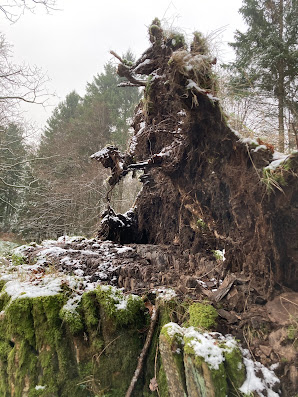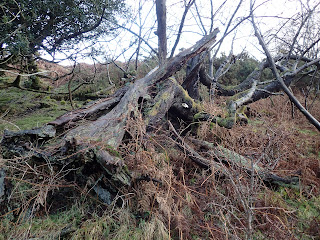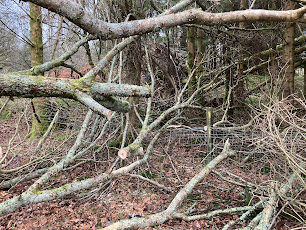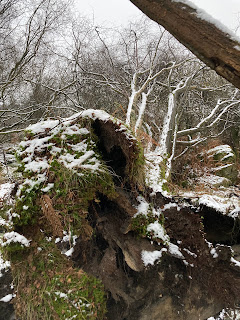Last year we experienced a number of significant storms. Storm Arwen in November 2021 was the greatest in terms of a weather event but then we had a series of three storms in February 2022 - Eunice, Dudley and Francis. Storm Arwen and Storm Francis led to over a dozen trees in Bel's Wood tumbling to a horizontal position. As spring has arrived I have checked on their wellbeing and all but one of the deciduous trees have come into leaf and blossom. There is a holly tree which is hanging on but doesn't look healthy. I have gone over old photographs to see if I can show the trees before the storm, immediately after and now as they are in leaf.
This cherry looked dead when I first got to know the wood in January 2021 so had fellen over long before the recent storms. With that large white fungus working its magic, dissolving the lignin, I had thought it was dead wood slowly rotting into the land.
But as last year, it has produced leaves and flowers and continues to live; just horizontally.
My question is whether this is an unusual outcome.
I joined a zoom call in November 2021 run by Cumbria Woodlands after Storm Arwen which had been called to support woodlanders in their response to storm damage. There are legal issues about making trees safe and also guidance on when to leave a tree in place and when to tidy it up when it has fallen. The key take away for me from the discussion was that trees falling in storms is not a tragic event but a natural process. Many trees continue to live on and with the root plate lifting out of the ground, new habitats are created which are useful for small mammals and invertebrates. If the tree doesn't survive, then it creates a new habitat and slowly rots with the help of fungi and replenishes the soil. Birds and bats enjoy dead trees for nesting in and for the insect life that thrives there. As spring has come those wise words have proved to be true.
This beautiful oak, near Cecelia fell in Storm Arwen. Happily not the lovely old Cecelia seen here in the winter sun but the oak standing in front and to the left. Of course you never know which tree may fall and this is the clearest shot I have of this one that has fallen.
Cecelia survived and you can see her roots are slotted into the rocky bank lower down.
The oak that has fallen was perched on top with shallow roots. Storm Arwen came from the north which is unusual. Prevailing winds come from the southwest so this tree has been protected by Cecelia but there is nothing nearby to the north.
This photo was taken the day after Storm Arwen
This is the upended root plate showing the shallow soil and rock below
It is hard to get a sense of scale so my friend Mags has helpfully stood by the root plate and the fallen tree to give a sense of scale. This is a large oak maybe 80 years old.
The crown of the tree has fallen across the fence with my neighbour and so I have needed to tidy it but apart from that the tree has remained undisturbed.
It is with real delight to see this tree is in full leaf and looks healthy (and a good wood store for fires).
A similar aged oak fell during Storm Francis with a before shot and Sue giving a sense of scale just after Storm Francis!
This tree is also looking healthy in full leaf with Mags giving scale below with a close up of the root plate showing the new habitats.
This silver birch has defied the odds and is thriving.
I have used my sticks to give a sense of scale. This twisted and broken tap root is doing its job. I don't have any before photos of this one.
Here you can see the crown lying horizontally
There are a number of other fallen silver birches around the beck which are also thriving
It is hard to unscramble what is happening here. There are 3 trees that have fallen across the beck.
I have embraced the idea that trees fallen can be a positive but I am sorry to see this rowan fallen. I had no trouble in finding 'before' photographs of this tree and have included just a few here.
And after Storm Francis - again caught out by a northerly wind.
Good to see the rowan continuing to thrive even if it will now live at a jaunty angle to the world.
There are two mature and huge willow trees down at the bottom of the site. One has always looked to be in good health while the other has been struggling with horses hoof fungus on the trunk and the leaves last year were sparse and there was only a small crop of flowers. The one on the left (Wilhelmina) remains in healthy and a good place to sit and watch the bumblebees feasting. The one on right did not survive Storm Arwen.
And more branches have fallen since as you can see here. Since there are few visitors this is not a hazard so can sit and deteriorate slowly over time.
The horse hoof fungus can be seen on that middle branch although the picture is dark - look for a white horizontal line the width of the trunk.
This white beam is lying downhill yet the flowers are sitting horizontally as if the tree were vertical which is neat considering it has always grown on a slope. It must have an internal spirit level! (I suspect the sun is its point of reference)
I don't think this holly will survive. I suspect losing the protection from the gorse has newly exposed this tree unused unprotected exposure to high winds. Happily there are some fine holly trees nearby.
Ultimately of course, all the trees will die and create new habitats. This tree has been dead since I arrived and watching it deteriorate I am learning that this is an active process that the storms have hastened along.
Before the storm the tree was succumbing to fungus in Spring 2021
After Storm Francis November 2021 - the top branches have broken off and this process is continuing
Scarlet elf cap appeared in the new year.
My aim is to leave these fallen trees where they fall and to watch as they thrive or deteriorate. The only one that may need attention is the large willow which is taking a lot of ground space which is earmarked for new trees. If at the end of the summer it is still in tact on the ground I may cut away some of the fallen trunks to create the space to plant new trees next year.
So to finish off the story, here is one of my favourite trees, now called Gandalf (thanks to Marion Macarthur). He is fine specimen with a 'dead' crown but appears to be thriving. Just another stage in the life of a veteran oak tree.













































Comments
Post a Comment